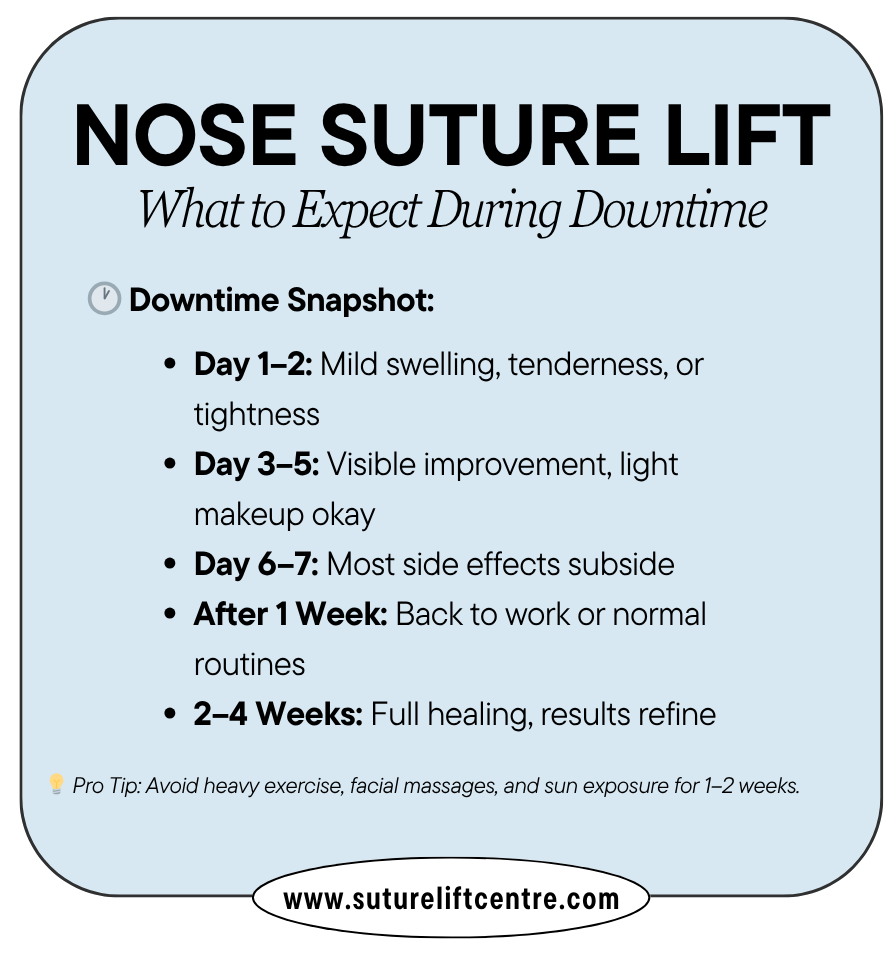Nose suture lift comes in: a rising trend in non-surgical facial tweaks that’s turning heads (and lifting noses) without the scalpel. Unlike traditional rhinoplasty, this procedure doesn’t involve breaking bones or weeks of downtime. Instead, it uses fine threads—yes, threads—to subtly shape and lift the nose in under an hour. Sounds almost too simple, right?
In this post, we’ll break down how it works, what to expect, and why more people are choosing this low-commitment alternative to rhinoplasty. If you’re exploring ways to enhance your look without going under the knife, this might just surprise you.
Key Takeaways
- A nose suture lift is a minimally invasive procedure that lifts and shapes the nose using special threads.
- The results are designed to look natural and can last for a long time, making it a popular choice for those seeking subtle enhancements.
- Recovery time is generally short, with minimal discomfort and downtime involved after the procedure.
- It’s important to choose a qualified practitioner who has experience in performing nose suture lifts to ensure the best results.
- Personal consultations are crucial to tailor the treatment to your specific needs and to set realistic expectations.
Understanding The Nose Suture Lift Basics

What Is A Nose Suture Lift?
Nose suture lift is a minimally invasive procedure designed to reshape and lift the nose without the need for traditional surgery. Instead of cutting and removing cartilage or bone, the practitioner will use special sutures to gently lift and contour the nose to achieve the desired aesthetic. It’s a great option for patients looking for a less invasive way to refine their nasal appearance.
How Does The Procedure Work?
After a consultation to discuss your goals and assess your nasal structure, local anaesthesia is used to numb the area. Then, through tiny entry points, sutures are carefully inserted beneath the skin to lift and reshape the nose.
These sutures act like an internal support system, gently repositioning the tissue for a more refined look. The best part? It’s done without major incisions—meaning minimal scarring and a faster recovery. Since the sutures are permanent, the results are designed to last.
Who Is An Ideal Candidate?
Who’s the perfect candidate for a nose suture lift? Generally, it’s someone who wants to improve the shape or position of their nose but isn’t keen on undergoing a full surgical rhinoplasty.
Ideal candidates often include:
- People with a slightly droopy nasal tip.
- Those seeking a more defined nasal bridge.
- Individuals who want to correct minor asymmetry.
- Patients who have had previous rhinoplasty and want a slight refinement.
It’s important to have realistic expectations and understand that a suture lift can achieve subtle but noticeable improvements. If you’re looking for a dramatic transformation, traditional rhinoplasty might be a better option. A consultation will help determine the best approach for your specific needs.
Benefits Of A Nose Suture Lift
Minimally Invasive Approach
The best thing about a nose suture lift? It’s minimally invasive. With no need for general anaesthesia or major incisions, the procedure is gentler on the body and comes with a quicker recovery time.
This translates to reduced swelling, bruising, and discomfort compared to traditional rhinoplasty. It’s a great option if you want subtle changes without the risks and downtime of a full surgical procedure.
Long-Lasting Results
While not as dramatic or transformative as surgical rhinoplasty, nose suture lifts use permanent threads that are intended to provide long-lasting structural support and results. The sutures used are designed to stay in place and provide support for an extended period. You can expect to enjoy the benefits of your nose suture lift for several years.
Factors like your age, skin type, and lifestyle will influence how long the results last, but generally, patients are very happy with the longevity.
Natural-Looking Enhancements
One of the biggest advantages of a nose suture lift is the ability to achieve natural-looking results. The procedure is designed to subtly reshape and contour the nose, rather than making drastic changes.
This means you’ll still look like yourself, just a more refined version. The goal is to enhance your existing features and create a more balanced and harmonious appearance. It’s perfect if you’re after subtle improvements that don’t look artificial or overdone.
A nose suture lift offers a fantastic middle ground for those seeking aesthetic improvements without the commitment of traditional surgery. It’s about subtle refinements that make a big difference in your overall confidence and appearance.
Aftercare & Recovery: What to Expect

Pre-Procedure Consultation
The first step is always a consultation—but it’s more than just a quick chat. This is where your goals, expectations, and nose structure are carefully reviewed to determine if a suture lift is the right fit.
Being open about what you’re hoping to achieve is key, as it helps ensure realistic results and a shared understanding. Your medical history will also be discussed to flag any factors that might affect the procedure or healing process.
During The Procedure
Right, let’s talk about the day itself. A nose suture lift is a minimally invasive procedure, which means it’s not like going under the knife for a full-on nose job. Usually, it’s done under local anaesthetic, so you’ll be awake but won’t feel any pain. Tiny incisions are made, and then special sutures (threads) are inserted to reshape and lift the nose. The whole thing usually takes less than an hour, which is pretty good, right? You might feel a bit of pressure or pulling, but it shouldn’t be painful. We’ll keep you comfortable and talk you through each step.
Post-Procedure Care
Straight after the procedure, you might have some slight swelling or bruising, but don’t worry, that’s totally normal. The practitioner will provide specific aftercare instructions., which usually include:
- Applying cold compresses to reduce swelling.
- Avoiding strenuous activities for a week or so.
- Sleeping with your head elevated.
- Taking any prescribed medication as directed.
Recovery And Aftercare Guidelines
Managing Discomfort
It’s normal to experience some mild pain, swelling, and bruising after the procedure. Don’t worry, it’s all part of the healing process.
Here’s what I usually recommend to my patients:
- Pain Relief: Over-the-counter pain relievers like paracetamol or ibuprofen can usually do the trick. Just stick to the recommended dosage.
- Cold Compresses: Applying cold compresses to the area for the first 24-48 hours can help reduce swelling and bruising. Icing on and off for about 15-20 minutes at a time is a good shout.
- Sleeping Position: Try to sleep with your head elevated for the first few nights. This helps to minimise swelling. An extra pillow or two should do it.

Follow-Up Appointments
Follow-up appointments play an important role in the overall success of a nose suture lift. They’re a chance to check that everything is healing properly and that your results are settling as expected. It’s also a great opportunity to ask questions or bring up any concerns.
Typically, the first follow-up is scheduled about a week after the procedure, with another one a few weeks later. If anything feels off in between, don’t wait—reach out. Ongoing support is a key part of making sure you feel confident and cared for throughout the process.
Potential Risks And Considerations
While it’s generally a safe procedure, it’s important to be aware of what could happen.
Common Side Effects
After the procedure, you might notice some swelling, bruising, or redness around the nose. That’s pretty standard, and it usually calms down within a week or two. Some patients also report a bit of tenderness or discomfort, but nothing a mild painkiller can’t sort out.
In rare cases, there might be some temporary numbness or tingling. It’s also possible to feel the sutures under your skin, but that usually becomes less noticeable as time goes on. If any of these side effects seem excessive or last longer than expected, definitely give the clinic a ring.
Long-Term Considerations
While suture lifts are designed to be permanent, the ageing process doesn’t just stop, does it? Over time, your skin will naturally continue to change, and that initial lift might not look quite as dramatic as it once did. It’s also worth remembering that significant weight fluctuations can affect the results.
And, although rare, there’s a small chance of suture migration or extrusion, which might need a bit of tweaking to fix. It’s all about managing expectations and understanding that this isn’t a magic wand, but a helping hand in the ageing game.
When To Seek Medical Advice
While most side effects are mild and temporary, there are a few things you should keep an eye out for. If you notice any signs of infection, like increased redness, swelling, pus, or a fever, get in touch with your doctor pronto.
Persistent or severe pain that doesn’t respond to painkillers is another red flag. And, if you’re worried about anything at all, don’t hesitate to seek medical advice.
It’s important to remember that everyone’s different, and your experience might not be exactly the same as someone else’s. Open communication with your practitioner is key to addressing any concerns and ensuring the best possible outcome.
Choosing The Right Practitioner
It’s really important to find the right person to do it. It’s a medical procedure and you want someone who knows their stuff. Let’s break down what to look for.
Importance Of Experience
Experience is key. You wouldn’t want someone practising on your face, would you? Look for a practitioner who has performed a good number of suture lifts. Check before-and-after photos, read reviews, and don’t be afraid to ask how many procedures they’ve done.
A seasoned practitioner will be able to handle any unexpected issues that might pop up during the procedure and will have a better understanding of how to achieve the results you’re after.
Questions To Ask
When you’re chatting with potential practitioners, come prepared with questions. Here are a few to get you started:
- How many suture lift procedures have you performed?
- Can I see before-and-after photos of your patients?
- What are the potential risks and complications?
- What is your approach to aftercare?
- What kind of sutures do you use?
Asking these questions will give you a better feel for the practitioner’s knowledge, experience, and approach to the procedure. It’s also a good way to gauge whether they’re a good fit for you personally.
Understanding Credentials
Make sure your practitioner is properly qualified and certified. Check their medical background, training, and any specialist qualifications they might have. Don’t be shy about asking for proof of their credentials.
Look for registration with relevant medical bodies and make sure they have the appropriate insurance in place. This gives you peace of mind that they are operating to a high standard and are accountable for their work.
Personalising Your Nose Suture Lift Experience
Tailoring The Treatment Plan
One of the best things about this procedure is how adaptable it is. It’s not a one-size-fits-all deal. Your practitioner should spend time understanding exactly what you want to achieve. This means looking at your nose shape, considering your overall facial structure, and listening to your specific concerns.
Maybe you want a subtle lift at the tip, or perhaps you’re after a smoother bridge. Whatever it is, a good plan will be designed just for you.
Setting Realistic Expectations
It’s important to have a clear idea of what’s achievable. Your practitioner should walk you through the potential outcomes, showing you before-and-after photos of similar cases and explaining the limitations of the procedure.
This isn’t about creating a completely new nose; it’s about enhancing what you already have. Think subtle refinement, not radical transformation.
Building A Trusting Relationship
You’re putting your face in someone else’s hands, so you need to feel comfortable and confident. Choose a practitioner who listens to you, answers your questions honestly, and makes you feel at ease. Trust your gut – if something doesn’t feel right, it probably isn’t.
A good relationship with your practitioner will not only make the whole process smoother but also help you achieve the best possible results. After all, it’s a partnership, and you’re both working towards the same goal: a happier, more confident you.
It’s all about finding someone who gets you, understands your vision, and has the skills to make it happen. Don’t rush the process; take your time to find the right fit. Your nose (and your peace of mind) will thank you for it.
Conclusion
Choosing to enhance your appearance—especially something as central as your nose—is a deeply personal decision. Understanding how a nose suture lift works, what to expect, and whether it’s right for you is key to making a safe, confident, and informed choice.
This procedure may be minimally invasive, but it still deserves careful consideration. Take the time to research, ask thoughtful questions, and consult with experienced professionals who prioritize your goals and well-being.
At the end of the day, it’s not just about changing how you look—it’s about feeling more comfortable and confident in your own skin. And with the right information, you’re in control of that journey.
Frequently Asked Questions
What is a Nose Suture Lift?
A Nose Suture Lift is a non-surgical procedure that uses special threads to lift and shape the nose, giving it a more defined look without the need for invasive surgery.
How does the procedure work?
During the procedure, the doctor inserts threads under the skin of the nose. These threads are placed under the skin to physically lift and support the nasal structure. They may also stimulate collagen, which can improve firmness over time, but the main effect is immediate structural lifting.
Who is a good candidate for this treatment?
Ideal candidates are those looking for subtle enhancements to their nose’s shape and who want a minimally invasive option instead of traditional surgery.
What are the benefits of a Nose Suture Lift?
The main benefits include a natural-looking lift, minimal downtime, and long-lasting results, as well as improved skin elasticity due to collagen stimulation.
What should I expect during recovery?
Recovery is usually quick, with most patients experiencing minor discomfort and swelling that typically resolves within a few days.
Are there any risks involved?
Like any procedure, there are some risks, such as swelling, bruising, or infection, but these are generally rare and manageable.




